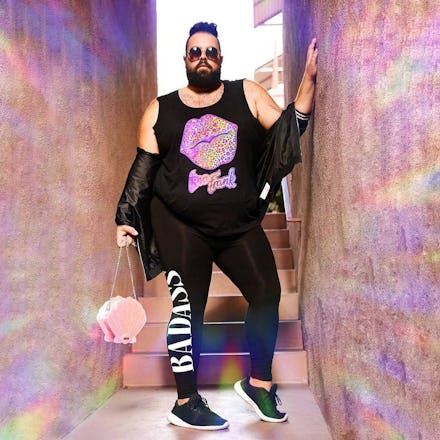The comments section of a Torrid Instagram post paints a bleak picture of body positivity

If you truly want body positivity to be about acceptance and encouraging every single person to love their bodies and dress how they want to dress, then the reactions to this post on plus-size retailer Torrid’s social media should be pretty distressing for you.
Last week, Torrid posted a picture of plus-size male model and blogger Troy Solomon decked out in its Lisa Frank tank top, leggings that read “badass” and a pink shell purse on both its Facebook and Instagram pages.
It quickly blew up. On Torrid’s Facebook, where pictures usually earn about 20 comments or so, Solomon’s post has more than 1,000, with more than 8,600 likes. On Torrid’s Instagram, the post earned hundreds of comments and more than 9,000 likes.
While plenty of people were praising Solomon modeling for Torrid, a plus-size womenswear brand, writing things like “Can I just ask if the top is on website already because I am loving it! And that cute little purse is the best,” and “Thank you for showing that clothing doesn’t have a gender,” many others were quite bothered.
“Who is this dude? I thought this shop was only for woman?” one commenter wrote. Another: “I’m confused. Torrid makes clothes for men now?” And another: “Nothing like catering to an insignificant portion of consumers while isolating the base of your consumers.”
Because of this post alone, some people announced on Instagram that they’d never be shopping at Torrid again.
This isn’t Solomon’s first time appearing on the brand’s social media. Months ago, he attended a pool party hosted by the brand and Torrid posted a picture from the event that showed Solomon posing with women. This is, however, the first time Torrid’s posted a solo picture of Solomon, decked in Torrid clothes.
As a man on the internet who is pushing for a more open discussion around men and body positivity via his Instagram, did Solomon expect this kind of reaction from customers of a store that also promotes body positivity?
“If I’m being honest, I wasn’t surprised by the reaction at all,” Solomon said in an interview. “I knew this could potentially be a big moment for myself and the brand, tapping into such a large audience of all different walks of life. And I know that a lot of what I do and what I put out into the social media realm can be considered controversial for a lot of people. I tend to blur the line between gender roles and how they are reflected in fashion and I know this is still a relatively new concept, but a very important one.”
Still, Solomon had plenty of defenders who quickly responded to some of the angrier comments. “I don’t know why it is a shock to some of you that Torrid may have non-heteronormative customers,” one commenter wrote on Facebook. “Before their mainstream rebranding they basically were a plus-sized Hot Topic, and catered to full-figured alternative lifestyle shoppers.”
“I’d like to take a poll and ask how many women here have ever worn/bought something from the men’s section?” a commenter asked on Instagram. “Or borrowed a shirt or bottoms from a dude in their life? What’s the effing difference?”
“We love our customers,” a Torrid spokesperson told Mic. “And whoever wants to buy our clothes instantly becomes our customer (and part of the Torrid family). When we see someone showing love for our brand, we often repost it. No politics, no drama — just fun, fashion and family.”
Although this discourse may be discouraging for people who thought we were at the stage where a man could model for a womenswear brand (and vice versa) with little fanfare, Solomon insists that it’s absolutely vital that we have these kinds of discussions.
“If the body positivity movement is going to be a success, there can’t be any exceptions,” Solomon said. “People can’t just be positive towards the bodies that look like theirs or the ones they admire on social media. The movement is about accepting and loving everyone of all shapes and sizes, regardless of how they choose to present themselves; it has to be all or nothing. If this experience has shown me anything it’s that even though a lot of people are on the same page, we have a ways to go.”